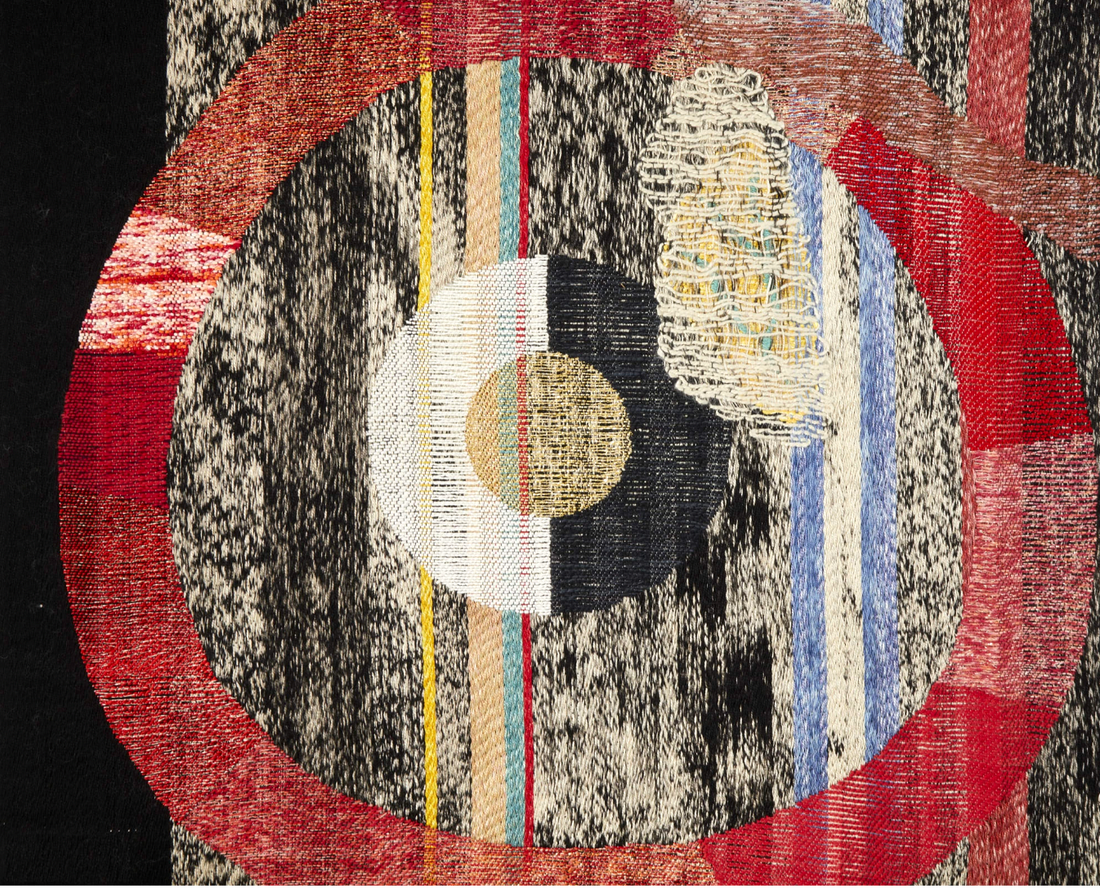
Bhakti Ziek: A Tenuous Thread
Words by Jordan Eddy
“Weaving is always slow compared to most methods of making,” Bhakti Ziek recently wrote to me.
For example, when she hand-weaves a brocade structure, Ziek can complete about one quarter-inch passage per hour at most. Look around this retrospective, representing over 50 years of Ziek’s fiber practice, and consider the patient math of her monumental endeavour. A Tenuous Thread captures the dynamic between Ziek’s voracious artistic intellect and humanity’s most intricate and painstaking sculptural discipline. The exhibition also charts the technological leaps that brought Ziek into prolific harmony with her practice.
 Image and image above: Bhakti Ziek, A Wheel of Life: the passing on of knowledge, 1989. Painted warp; braided and resist-dyed weft; lampas weave, double-sided weaving.
Image and image above: Bhakti Ziek, A Wheel of Life: the passing on of knowledge, 1989. Painted warp; braided and resist-dyed weft; lampas weave, double-sided weaving.
Now a septuagenarian living in Santa Fe, Ziek has traveled the world seeking craft knowledge and artistic inspiration. Her path begins in New York City, where she was born in 1946 and first studied weaving at the Craft Students League. It winds through Mexico, Guatemala, Kansas, Michigan’s Cranbrook Academy of Art, the Philadelphia College of Textiles & Science (PCT&S), Chicago, Arizona, India, Italy, Vermont, and beyond.
 Installation view of Bhakti Ziek: A Tenuous Thread, form & concept. Image courtesy of Marylene Mey and Byron Flesher.
Installation view of Bhakti Ziek: A Tenuous Thread, form & concept. Image courtesy of Marylene Mey and Byron Flesher.
The foundation of Ziek’s weaving practice is analog; early in her career, she mastered myriad weave structures by hand on the floor loom, backstrap loom and tapestry loom. She first encountered a jacquard loom, which automates elements of the weaving process, in 1986 during her studies in Manhattan. In 1991, she was teaching at PCT&S when the institution swapped its 19th-century jacquard looms for fully electronic jacquards that could be digitally programmed.
 Image: Bkati Ziek, Chakras, 1985. Painted warp; handwoven brocaded satin weave.
Image: Bkati Ziek, Chakras, 1985. Painted warp; handwoven brocaded satin weave.
Ziek has since established herself as a preeminent scholarly authority on the artistic use of the computerised jacquard loom—and has used the technology to supercharge her own practice. A Tenuous Thread features artworks from every phase of Ziek’s creative evolution, from her formative studies of techniques and aesthetics across the world, to her career-spanning efforts to textually surface the knowledge that is encoded in her textiles.
One entry point to this exhibition is Wheel of Life, Ziek’s early-career magnum opus that wrestles with legacies of the theft and dissemination of knowledge in craft community. There are two churning endpoints: Ziek’s floor loom, which she will activate throughout the show, and a display of her former students on our second-floor catwalk.
 Image: Bhakti Ziek, Natural Dyes - #2, 2003. Warp ikat with natural dyes (cochineal, coffee, indigo, madder, osage orange); handwoven lampas pickup weave.
Image: Bhakti Ziek, Natural Dyes - #2, 2003. Warp ikat with natural dyes (cochineal, coffee, indigo, madder, osage orange); handwoven lampas pickup weave.
Bhakti Ziek: A Tenuous Thread is on show at form & concept, Sante Fe until 27 April 2024.
Find out more and plan your visit:
www.formandconcept.center/bhakti-ziek-a-tenuous-thread-exhibition-guide
“Weaving is always slow compared to most methods of making,” Bhakti Ziek recently wrote to me.
For example, when she hand-weaves a brocade structure, Ziek can complete about one quarter-inch passage per hour at most. Look around this retrospective, representing over 50 years of Ziek’s fiber practice, and consider the patient math of her monumental endeavour. A Tenuous Thread captures the dynamic between Ziek’s voracious artistic intellect and humanity’s most intricate and painstaking sculptural discipline. The exhibition also charts the technological leaps that brought Ziek into prolific harmony with her practice.

Now a septuagenarian living in Santa Fe, Ziek has traveled the world seeking craft knowledge and artistic inspiration. Her path begins in New York City, where she was born in 1946 and first studied weaving at the Craft Students League. It winds through Mexico, Guatemala, Kansas, Michigan’s Cranbrook Academy of Art, the Philadelphia College of Textiles & Science (PCT&S), Chicago, Arizona, India, Italy, Vermont, and beyond.

The foundation of Ziek’s weaving practice is analog; early in her career, she mastered myriad weave structures by hand on the floor loom, backstrap loom and tapestry loom. She first encountered a jacquard loom, which automates elements of the weaving process, in 1986 during her studies in Manhattan. In 1991, she was teaching at PCT&S when the institution swapped its 19th-century jacquard looms for fully electronic jacquards that could be digitally programmed.

Ziek has since established herself as a preeminent scholarly authority on the artistic use of the computerised jacquard loom—and has used the technology to supercharge her own practice. A Tenuous Thread features artworks from every phase of Ziek’s creative evolution, from her formative studies of techniques and aesthetics across the world, to her career-spanning efforts to textually surface the knowledge that is encoded in her textiles.
One entry point to this exhibition is Wheel of Life, Ziek’s early-career magnum opus that wrestles with legacies of the theft and dissemination of knowledge in craft community. There are two churning endpoints: Ziek’s floor loom, which she will activate throughout the show, and a display of her former students on our second-floor catwalk.

Bhakti Ziek: A Tenuous Thread is on show at form & concept, Sante Fe until 27 April 2024.
Find out more and plan your visit:
www.formandconcept.center/bhakti-ziek-a-tenuous-thread-exhibition-guide
